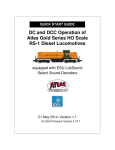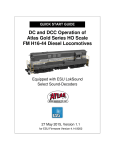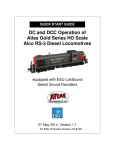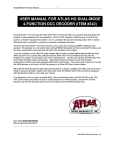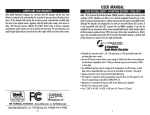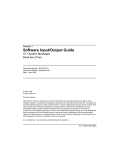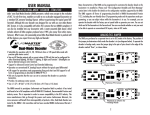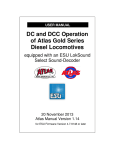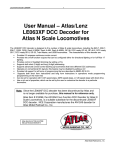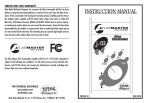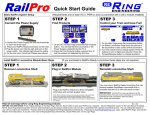Download DC and DCC Operation of Atlas Gold Series HO Scale C424/C425
Transcript
DC and DCC Operation of Atlas Gold Series HO Scale C424/C425 Diesel Locomotives equipped with ESU LokSound Select Sound-Decoders 12 May 2014, Version 1.1 for ESU Firmware Version 4.10.9171 Quick Start for DC and DCC Operation of Atlas Gold Series HO-Scale Alco C424/425 Locomotives Equipped with ESU LokSound Select Sound-Decoders Congratulations on your purchase of an Atlas Master™ Gold Series HO-scale model of an Alco C424/C425 locomotive that is factory-equipped with an ESU LokSound Select sound-decoder. This sound-decoder provides the highest quality sound plus state-of-the art motor control. Your locomotive can run on either conventional DC (with basic features) or on NMRA Digital Command Control (with full features). This document describes the features of the LokSound Select sound-decoder installed in the Atlas HO Gold Series Alco C424/C425 locomotive when the locomotive is operated on DC and on DCC power. Please note that a few updates to the software used in this locomotive have been made. As a result, certain DCC function buttons operate somewhat differently than they did in the first two Atlas HO Gold Series locomotives (RS-3 and S-2) that were equipped with LokSound Select sound-decoders. You can [1] download from the Atlas website the current version of the Atlas User Manual , which includes this locomotive. This User Manual explains in detail the differences in DCC function key operation between various ESU software versions, as well as giving a more complete description of both DC and DCC operation. DC Operation of your Atlas HO-scale Gold Series C424/C425 Locomotive Using a standard variable-voltage DC power pack, turn the DC throttle up slowly until you begin to hear locomotive sounds (around 5 volts). You will hear the diesel engine Start-Up sound sequence, which lasts about 25 seconds. The locomotive will NOT move before the Start-Up sequence has been completed. The headlight facing the direction in which the locomotive will move turns on in its Dim state. Once the start-up sequence has been completed, turn up the throttle voltage up (to about 7 volts) until the locomotive starts to move. Note that you must turn the throttle to a higher setting than you would to make a non-sound locomotive start to move. The locomotive starts moving slowly due to built-in inertia from the BEMF (Back EMF) motor control. The headlight in the direction of movement will turn from Dim to Bright; the headlight facing the opposite direction will be Off. On a DC-powered layout, an Atlas HO-scale Gold Series Alco C424/C425 locomotive will automatically produce sounds that are appropriate for its current state of operation. For example, the Startup sound sequence plays before the locomotive begins to move, and Brake Squeals play as the locomotive grinds to a halt. However, it is not possible to trigger individual sounds (such as the horn or bell) manually with DC track power. If you wish to have manual control of sounds, Atlas suggests that you invest in a Basic DCC System which will allow you to control all available sounds and other special effects in your locomotive and yet be essentially as simple to operate as a DC power pack. Basic DCC Systems that are currently available include the: - NCE DCC Twin, - MRC Prodigy Explorer DCC, - MRC TECH 6 Sound Controller 6.0 (usable in smaller scales, but primarily intended for O-scale and larger). Moreover, one can change certain operational characteristics of the locomotive when operating on DC power, using the same DCC programming that is used to change these characteristics in DCC operation. See Reference [1] for details. However, a Standard (full-featured) DCC System, as opposed to a Basic DCC System, may be needed to make some or all of these changes. 2 DCC Operation of your Atlas HO-scale Gold Series C424/C425 Locomotive • Start-Up Behavior As shipped from the factory, this locomotive behaves as follows at start-up: - Locomotive sounds will start up immediately after DCC power is applied to the track. You will first hear the sounds of a diesel locomotive starting up from a powered-down state, followed by normal idling sounds and (after the DCC throttle is advanced) running sounds. - Even if you advance the DCC throttle, the locomotive will NOT move until AFTER the entire Start-Up sound sequence has played. If the above behavior at startup is acceptable, there is nothing more that you need to do. If, however, you would like your locomotive to behave differently, see Example 3 in Appendix 4 of Reference [1] to change the behavior described in the first Dash item and Example 1 in Appendix 4 of this same reference to change the behavior described in the second Dash item • DCC Functions Available in Atlas HO-Scale Gold Series Alco C424/C425 Locomotives The ESU LokSound Select sound-decoder provides a number of different DCC functions that can be triggered by pressing the appropriate key (e.g., press the “5” key to trigger DCC Function #5) on your DCC controller. The following table lists the DCC functions available in the ESU LokSound Select sound-decoder installed in Atlas Gold Series HO-scale C424/C425 locomotives. DCC Function Key Operation for Atlas HO-scale Gold Series C424/C425 Locomotives Function Key Locomotive Behavior when Press Function Key F0 F1 F2 Horn F3 F4 Front and Rear Headlights are directional. st nd Bell (1 push on/2 push off) Horn blows until push F2 key again Horn blows only while Horn key held down Two Coupler Clank sounds alternate st nd Diesel Fans (1 push on/2 push off) st nd Dynamic Brake Fan (1 push on/2 push off) Only active when prime mover sound on st nd Optional Ditch Lights (1 push on/2 push off) st nd Switching Mode (1 push on/2 push off) Audio Mute and Start Up/Shut Down st Manual Notching Up sounds (1 push nd on/2 push off) st Manual Notching Down sounds (1 push nd on/2 push off) st nd AUX3 Function Output (1 push on/2 push off). Preset to MARS light F5 F6 F7 F8 F9 F10 F11 3 Function Behavior (Latching or Non-latching) Latching Latching Latching Non-Latching Non-Latching Latching Latching Latching Latching Latching Latching Latching Latching Works Only with Engine Sounds On Works Only When Moving No No No No No No No Yes No No Yes Yes - - No No No No Yes No Yes No - - DCC Function Key Operation for Atlas HO-scale Gold Series C424/C425 Locomotives (continued) Function Key Locomotive Behavior when Press Function Key st F12 F13 Function Behavior Works Only with Engine Sounds On Works Only When Moving No Yes - - nd Dim Headlight (1 push dim/2 push bright) st nd AUX4 Func Output (1 push on/2 push off) Latching Latching F14 Talking Defect Detector sounds Detector sounds play each time F14 is pressed No No F15 Cab Radio Communication sounds Radio communication sounds play each time F15 is pressed No No Latching Yes Yes Non-Latching Latching Yes Yes Yes No Press F19 twice Latching No No Yes No No No F16 F17 F18 F19 F20 F21 Rail-joint Clank sounds (1st push on/2nd push off) Only active when prime mover sound on Brake Set/Release sounds with each push st nd Sanding Valve sounds (1 push on/2 push off) Short Air Let-off sounds st nd Air Compressor sounds (1 push on/2 push off) st nd Pop Valve sounds (1 push on/2 push off) Latching Section 4.1 in Reference [1] explains the operation of DCC functions F1 to F21 in detail. Default Headlight Operation in Atlas HO-scale Gold Series C424/C425 Locomotives Since prototype Alco C424/C425s were road locomotives, their headlights would normally be turned on only in the direction that the locomotive was moving. Furthermore, the switch controlling the headlight of a prototype locomotive is normally set to its dim position when the locomotive is standing still. The following table illustrates how Atlas’s model C424/C425 locomotive mimics this behavior. Light Front Headlight Rear Headlight Forward Bright Off Stopped after Forward Dim Off Reverse Off Bright Stopped after Reverse Off Dim When the locomotive is first powered up, you may need to press the F0 (or Headlight) key on your DCC system one or two times to turn on the directional front or rear headlight. 4 • DCC Programming Locations Most DCC systems allow you to program a Configuration Variable (CV), such as the DCC address of a locomotive, in either of two places: - On a special section of track not connected in any way to your layout and called the Program Track. (In DCC terminology, programming locomotives on the program track is called Service Mode Programming.) - Anywhere on the Main Line (regular track) of your layout. [In DCC terminology, programming a locomotive on the main line of your layout is called either Programming on the Main (POM) or Operations Mode (Ops Mode) programming.] • • In almost all cases, the ESU LokSound Select decoder installed in your Alco C424/C425 locomotive can be programmed on your program tack WITHOUT a Program Track Booster connected between the program track output of your DCC system and your physical program track. However, if you do need a Program Track Booster, Atlas recommends the PTB-100 from SoundTraxx. Programming a New DCC Address for Your Locomotive The decoder in every Atlas Gold Series locomotive comes from the factory set to use the short address “3.” However, in order to control (independently) several locomotives on the same track at the same time, it is necessary that each locomotive have a unique DCC address. A convenient choice for the DCC address is the road number printed on the side of the locomotive’s cab. Frequently, the number on the side of the cab is a 3- or 4-digit number, which is treated in DCC as a Long (or 4-digit) Address. If your DCC system allows you to program 4-digit addresses on the main line (many DCC systems do), Atlas recommends that you take advantage of this capability by programming the address of your Gold Series locomotive on the main line using Operations Mode (Ops Mode) programming. • Air Horn Selection For the Alco C424/C425, the default horn is a Nathan K5H (i.e., CV48 = 64). If you wish to use a different air horn, you may choose from the 16 air horns that are listed in the following table. To select a horn, write into CV48 the value listed to the right of the name of that horn in this table. Air Horn Name Nathan K5H Nathan K3L Nathan M5 Nathan P3 Nathan P5A Leslie S2M Leslie RS3L Leslie S3L Leslie S5T Nathan M3 Leslie RS3K Nathan K5H Leslie RS3L Nathan M3H Nathan K5H Leslie 3 Chime 5 CV48 Value 64 65 66 67 68 69 70 71 72 73 74 75 76 77 78 79 • Resetting your Lok-Sound Select Equipped Loco to Factory Default Values Resetting the firmware in the LokSound Select sound-decoder to its factory-built configuration can resolve many problems that sometimes occur with firmware-controlled electronics. In fact, we have found that at least 20 to 25 percent of the problems with Gold Series locomotives that we receive for repair at Atlas can be resolved simply by resetting the sound-decoder. Hence, the very first step you take to resolve a problem should be to reset the LokSound Select sound-decoder in your locomotive using the following procedure: - Place the locomotive on your program track and write the value 8 into CV8. - Cycle power to the decoder first off and then on again by: o Tipping the locomotive to one side so that all the wheels on the opposite side are off the rail, o Holding the locomotive in this tipped position for 5 to 10 seconds, o Slowly lowering the locomotive back down until all wheels are once again on the program track rails. The second dashed item listed above (power cycling) is extremely important; do not omit it. REFERENCES [1]. User Manual: DC and DCC Operation of Atlas Gold Series Diesel Locomotives equipped with ESU LokSound Select Sound-Decoders, Version 1.20, 07 May 2014 (or later). Download from Atlas model website: http://www.atlasrr.com/ Choose Support, DCC Support, and then double click on the listing for this document. [2]. LokSound Select User Manual for Diesel and Steam Decoders, Third Edition (or later), May 2012. You can download the ESU LokSound Select User Manual document from the ESU website: http://www.esu.eu/en/start/ by first selecting DOWNLOADS. Then click on Instruction Manuals. Next, click on Digital Decoders. Finally, single-click on the Download icon in the box labeled LokSound Select Users Manual. 6 Appendix: Body-Removal Instructions for Atlas HO-Scale C424/C425 Locomotives When reading these instructions, please refer to the exploded diagram and parts list that was packed with your Atlas HO C424/C425 locomotive. Instructions for Removing the Plastic Body Shell from an Atlas HO-scale C424/C425 Locomotive 1. The first thing to do is remove the fuel tank so that you have a place on the locomotive onto which you can hold. 2. Remove the couplers by unscrewing them. 3. Remove the hand rails from the cab and from the cab steps; do not remove them from the side sill casting. 4. There are three sets of tabs on the bottom of the shell that attach to the frame; refer to the exploded diagram for the locations of these tabs. 5. Push inwards at the rear of the shell to release the rear-most tabs on the shell from the frame. The tabs must clear the frame before the body can be removed. 6. Now push inwards on the shell at the location of the center set of tabs to release these tabs from the frame. 7. Finally, there are two tabs at the front of the shell. Release them in the same way that you released the rear and center sets of tabs. 8. Once all tabs are clear of the frame, the body shell should come off of the die-cast mechanism, but the sill casting will stay on. 9. Remember to be careful not to break the hand rails. _____________________________________________ ESU License Agreement Software License Agreement 1. ESU LokSound, GmbH & Co. grants you, the owner, and the right to use the software that is included with your LokSound Select system only with the locomotive that you purchased. 2. Copyright: The software is owned by Electronic Solutions Ulm GmbH & Co. and is protected by German copyright laws and international treaty provisions. Therefore, neither you nor anyone else may copy the software. Proprietary Rights and Obligations The structure and organization of the Software/Firmware are the valuable properties of Electronic Solutions Ulm GmbH & Co. You will not make or have made, or permit to be made, any copies of the Hardware, Software/Firmware code, or any portions thereof. You are not to modify, adapt, translate, reverse engineer, de-compile, disassemble or create derivative works based on the Hardware or Software/Firmware. Trademarks shall be used in accordance with accepted trademark practice, including identification of trademark owner’s name. The LokSound Select Hardware, Software, and Firmware are covered by various US and foreign patents and patents pending. No Other Rights Electronic Solutions Ulm, GmbH & Co. retains ownership of the LokSound Select Hardware design and operating Software/Firmware code. Except as stated above, this agreement does not grant you any rights to intellectual property rights to the LokSound Select Software, Firmware or Hardware. The use of any trademarks as herein authorized does not give you any rights of ownership in that trademark. ________________________________________________________________________________________________________________________________________________________________________________________________________________________________________________________________________________________ © 2014 All rights reserved. Information in this publication supersedes that in all previous published material. The contents and the product it describes are subject to change without notice. LokSound is a registered trademark of Electronic Solutions Ulm (ESU) GmbH & Co. MRC is a trademark of Model Rectifier Corporation. All other trademarks are the property of their respective holders. Atlas Model Railroad Co., Inc. makes no representations or warranties with respect to this publication. In no event shall ESU be liable for any damages, direct or incidental, arising out of or related to the use of this publication. Issued: 05/2014 7







